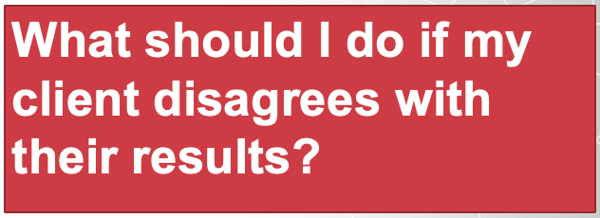What are some of the most commonly asked questions about DISC?
Today we're going to answer questions you often ask us! Let's get started!Is there a reason why D is red, I is yellow, S is green, and C is blue?

The colors do mean something. Color psychology has been around for quite a while. We can think of colors in relationship to human behaviors. Our assessment measures behaviors and tying what we know about colors to DISC styles helps build stronger associations.
The color red is often associate with strength, power, and determination. Red is considered a bold color; “I'm here!” We connect red to D-styles because D-styles tend to stand out by being bolder and 'large and in charge.'
I-styles are associated with the color yellow. Yellow is often seen as positive, bright, and sunny; an attention grabbing color. For example, taxi cabs are painted yellow in order to be easily noticed. I-styles tend to be energetic, positive, and enjoy being the center of attention.
We associate S-styles with the color green because green often associated with earthy nature. We often think of green as being calm, harmonious, and stable. S-styles tend to be described as 'Steady Eddies.' They are usually even-keel, easy-going, and pleasant.
The color blue is often seen as a distant and deep color; think about the vast and far away sea and sky. Blue is connected to being cooler, deeper, and more regal and formal; more like the C-style.
Demographically, is each DISC styles represented equally?
It's not uncommon to assume that each of the four DISC styles are equally represented; 25% per DISC quadrant. However, they are not, unlike some other DISC tools. The Extended DISC Assessment tool measures a person's hard-wired natural style. We are complex human beings so the numbers are simply a reflection of that.
 If you look at our most recent demographic data from our 2019 Extended DISC Global Validation Study you can see that D-styles account for 9% globally; only one in ten are actually dominant D-styles. The rest of the styles have higher representation. I-styles are 28%, S-styles are 32% and C-styles are 31%. These statistics may adjust over the years, but for the most part, the percentages tend to remain somewhat steady.
If you look at our most recent demographic data from our 2019 Extended DISC Global Validation Study you can see that D-styles account for 9% globally; only one in ten are actually dominant D-styles. The rest of the styles have higher representation. I-styles are 28%, S-styles are 32% and C-styles are 31%. These statistics may adjust over the years, but for the most part, the percentages tend to remain somewhat steady.
Does Extended DISC measure my personality?

We often hear our DISC tool being called a personality assessment, but it really is not. There is no one tool that capture all of it. The intention of the Extended DISC tool is not to measure a person’s entire personality. However, the tool does measure an important part of our personality; our natural behavioral style. Simply put, the tool has to predict how we do things; how we tend to react to our environment. Now we can make better decisions about how to best adjust our behaviors and interact with others.
The tool does not measure our skills, experience, values, knowledge, or attitude; all of which makes up the scope of our personality. The tool focuses on behaviors because behaviors are the part of us we can make effective adjustments to be more successful.
Can people trick the DISC assessment?

The direct answer is no. We believe strongly in creating a tool where you can trust the results. It's very difficult to manipulate the Extended DISC® assessment tool. The system has a built-in set of checks and balances to make sure people are really answering consistently to their natural style.
If a person tries to project a style they are not, then they will often get confused because the tool is measuring their unconscious hard-wired style. The system is able to detect these situations and identify them as less valid results or invalid results.
If you ever have a result that you would like a second opinion feel free to reach out to us to help.
What should I do if my client disagrees with their results?

We, as coaches, need to hear our client's objections and listen to what they have to say. We can help the client process their objections, which could be a blind spot. People tend to agree with their strengths and give pushback on their development areas. If they agree with their strengths then they are essentially identifying their DISC style, but may have blind spots.
A great way to manage pushback is to ask for feedback from people they trust. We may sometimes be blind to certain aspects of our own style, while others see them clearly. Blind spots can provide the greatest opportunities to improve our performance.
Additional tips include the awareness the results are a self-identification of their most comfortable ways of doing things and what tends to happen if they DON'T adjust. They may want to consider if the statements used to be true until they consciously worked on developing them. Also, ask them to reflect and process the information longer. With time, they may come to agree with the report findings on their own, 'Yes, that's me.' You should check the Profile's validity indicators to see if you can trust the results.
Ultimately, if they continue to disagree simply say, 'I believe you. You know yourself better than anyone.' Disregard the statement and focus on the big picture. No assessment can provide 100 percent accurate statements every time. The end goal is to use the information to help you be more successful.

